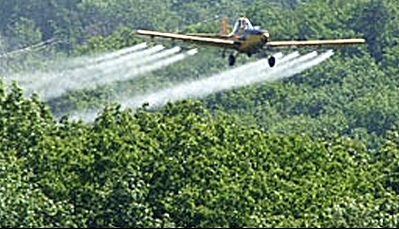Glyphosate use in Nova Scotian Forests

Glyphosate – What Is It?
Glyphosate – The Science (Research Links)
Glyphosate – In The News
Glyphosate – What You Can Do
Glyphosate fact sheet 2022 update.
By Rob Bright and Nina Newington
Every year in Nova Scotia, corporations apply for permission to spray glyphosate-based herbicides on their land. Every year Nova Scotia Environment issues a bunch of licenses, and every year citizens object. The latest UN climate report makes it clear we cannot afford business as usual, but that is what the Nova Scotia government is bringing us. Again.
Why do these landowners want a helicopter to fly over their land and poison a majority of the plants that are growing there?
Companies spray a young forest with glyphosate-based herbicides after it has been clearcut, usually 2-5 years after the cut. Done in late August/September, the spray kills off everything with a leaf, including hardwood trees like maple, oak and birch, leaving only trees with needles, such as spruce and fir. Industrial forestry favours these softwoods. The intent is to get rid of competition so the preferred species grow faster. The effect is to prevent regeneration of the natural Wabanaki-Acadian forest, leaving in its place an industrial tree farm.
Isn’t there a better way to reduce competition?
These corporations could pay workers to cut back the competing trees manually but that would cost more than hiring a helicopter to spray poison. In half an hour a helicopter can spray 200 acres. Aerial spraying is a “cheap” way to prevent the regeneration of a natural forest.
But getting rid of competition does help the trees grow, doesn’t it?
As it turns out, the kill-the-competition model is based on outdated science.
Forest ecologists are demonstrating that natural forests are healthier and more resilient because they are diverse. Different kinds of trees actually cooperate via fungal networks in the soil. Dr. Suzanne Simard’s 40 years of research on forestry and forest ecology has proven that industrial forestry’s kill-the-competition model of forest management is wrong.
What about all the costs the corporation isn’t paying?
Instead of creating jobs, the corporation hires a helicopter to poison the land and water from the air.
Instead of allowing a natural forest to regrow, supporting complex webs of life that in turn support people with ecosystem services, ecological deserts are created.
Instead of using the precautionary principle to protect the health of humans and wildlife, both corporations and our government choose to trust industry-funded studies that have proven to be inaccurate and full of flaws.
Our government allows these corporations to take the profits while we — and the planet — pay the costs.
But hasn’t Health Canada approved the use of glyphosate?
Yes. So has the EPA in the US. But there is a lot of money at stake for chemical companies. For a chilling look at how the system that is supposed to protect us works — or doesn’t work — check out
The European Food Safety Authority (Europe), Health Canada’s Pesticide Management Regulatory Authority (Canada) and the Food and Drug Administration (USA) only review the safety science done by the herbicide manufacturers. This research is usually unpublished, non-peer reviewed, and is often kept secret as proprietary information.
In 2015 the World Health Organisation’s International Agency for Cancer Research (IARC) declared that glyphosate was a Probable Human Carcinogen. The IARC used only published, peer reviewed, publicly accessible research on glyphosate.
It’s more than glyphosate
The safety research done on glyphosate-based herbicides (GBHs) only looks at the one ingredient, glyphosate. Research has found that the whole formulations of GBHs can be far more toxic than glyphosate alone, meaning the safety research does not realistically assess the true risks associated with using these herbicides.
In the United States, more than 120,000 lawsuits have been filed against Bayer-Monsanto claiming that exposure to glyphosate-based herbicides has caused a cancer called non-Hodgkin’s Lymphoma. The plaintiffs won the first three cases. Juries awarded the victims: Hardeman v. Monsanto, $80 million; Dewayne Lee Johnson v Monsanto, $289.2 million; and, Pilliod et al., v Monsanto, $2 billion. Bayer-Monsanto set aside $11.6 billion for settlements and litigation in the matter. In July 2021, they added a further $4.5 billion in case of an unfavourable ruling by the top U.S. court. They want any settlements they negotiate to state that there has been no admission of wrong doing and that they will still be allowed to sell glyphosate.
So Nova Scotia Environment has approved the aerial spraying of two glyphosate-based herbicides, Timberline and VisionMax, on parcels of privately-owned forested land. There are minimal safeguards: spraying shouldn’t happen if the wind is over 10-15km/h; there are 10m buffer zones from boundaries. Much is made of the laser precision of the helicopter sprayers. They never spray streams or rivers, so the claim goes. But when a glyphosate-based herbicide rains down from the sky, it kills any amphibian whose skin it touches including salamanders, frogs and toads. It coats the berries and leaves that wildlife and sometimes humans eat. It enters the top 6″ of soil and stays there for an undetermined length of time. Because glyphosate can permeate every part of a plant, it can remain in deep rooted plants far underground and into water courses. Anyone who has hiked in our woods knows there are swampy bits. These feed into more identifiable streams. So glyphosate ends up in watercourses. It is toxic to aquatic life. In lakes and ponds it feeds cyano-bacteria, the blue-green algae blooms that sicken people and kill pets.
